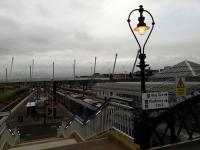This day in history 22 October
Images
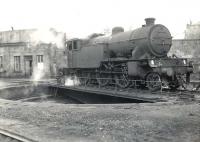
Helensburgh Shed: Parkhead V1 2-6-2T no 67629 being turned at Helensburgh shed on 22 October 1960 before returning east with a train from the adjacent Helensburgh Central station. See image [[49566]]
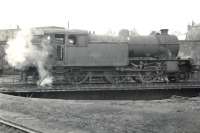
Helensburgh Shed: Parkhead V1 2-6-2T no 67629 on the turntable at Helensburgh shed on 22 October 1960.

Helensburgh Shed: J37 0-6-0 64541 on Helensburgh shed with the shedmaster standing alongside. The photograph was taken on 22 October 1960, planned to be the last Saturday of steam operations at 65H following electrification. However, as we all know, the best laid plans... Helensburgh shed finally closed on 31 October 1961.
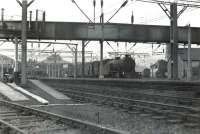
Helensburgh Central: Looking back along the platforms towards the station concourse at Helensburgh Central on 22 October 1960. V1 2-6-2T 67629 is preparing to leave with a train for Bridgeton Central. In the right background other steam locomotives are receiving attention on Helensburgh shed - see [[58275]].

Saltley: Fowler 0-6-0 no 44226 stabled in a siding alongside Saltley shed on a grey autumn day in 1964.
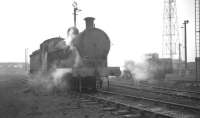
Bescot: The yard at Bescot in October 1964, with class G2A 0-8-0 no 49361 featured.

Birmingham Snow Hill: Ex-GWR 3808 takes an up goods train through Birmingham Snow Hill station in October 1964.
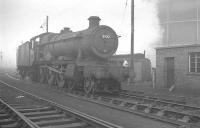
Banbury Shed: Ex-GWR Hall 4-6-0 no 5927 Guild Hall seen during its last operational days at Banbury on a a misty 22 October 1964. The locomotive was officially withdrawn by BR at the end of that month and cut up at Cashmores, Great Bridge, the following January.

Bescot: Ivatt 2-6-0 no 43022 of Bescot shed, takes a freight past the station in October 1964. (Note the station was renamed Bescot Stadium in 1991.)
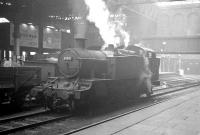
Birmingham Snow Hill: Collett 2-6-2T no 8109 potters around in the shadows at Birmingham Snow Hill on 22 October 1964, some 8 months before withdrawal from nearby Tyseley shed. On the adjacent line Churchward 2-8-0 3808 is passing through the station with an up goods train see image [[34443]].
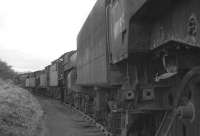
Barry: Lineup of withdrawn steam locomotives at Woodhams yard, Barry, on 22 October 1967. Nearest the camera is BR Standard class 9F no 92085, built at Crewe in June 1956 and withdrawn from 8H Birkenhead Mollington Street in December 1966. The 2-10-0 is recorded as being cut up here in July 1980.

Barry: Scene on the reception roads alongside the old goods shed at Barry in October 1967 with a depressed looking 9F nearest the camera. The locomotives are thought to be (from left to right) 71000 Duke of Gloucester, 75014, 42765 and 92134. See image [[40325]]

Haymarket MPD: Scene at Haymarket depot in October 1969, featuring two class 47s which had worked into Waverley earlier in the day on Anglo-Scottish expresses. On the left is Immingham based no 1863 off the 08.40 from Leeds, alongside D1976 which had brought in the the 07.20 from York.
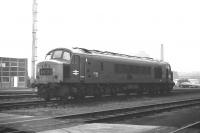
Haymarket MPD: Class 46 no D169 standing opposite the admin offices at Haymarket depot on a dull late October afternoon in 1969. From the reporting number it had worked in on the previous night's 22.30 from Kings Cross.
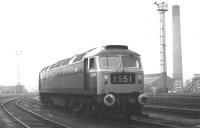
Haymarket MPD: D1976 at home on Haymarket depot on a gloomy Wednesday afternoon in late October 1969. Judging from the reporting number the locomotive had arrived back in Edinburgh earlier in the day with the 07.20 from York.

Haymarket MPD: Haymarket based Class 20 no 8326 stabled in the shadows alongside the main shed building in October 1969.

Haymarket MPD: While far from ideal photographic conditions (see the marker lights on the leading loco), this shot seems to capture the essence of how I remember late autumn/winter afternoons in Edinburgh in the late sixties/early seventies. It shows a pair of class 26s passing Haymarket depot with the 14.50 Edinburgh Waverley - Inverness (green D5335 and blue D5344, both of Inveness). Having restarted from its first stop at Haymarket the train will travel via the Glenfarg line, calling at Inverkeithing, Rosyth Halt, Dunfermline, Cowdenbeath and Kinross Junction to reach Perth at 16.03, quicker, if only by a few minutes, than the equivalent service today which stops only at Kirkcaldy and Markinch.

Haymarket MPD: The occasion of an Edinburgh University Railway Society shed visit to Haymarket TMD on 22nd October 1970 gave me the opportunity to try out my newly acquired first SLR, a Russian Zenith 3M which, whatever its faults, came with a sharp standard lens. One of the last shots taken that afternoon was this one of No. 9018 'Ballymoss' which, despite the empty left hand cab is probably waiting to go off shed to work the 16:00 to Kings Cross - it was taken well after the passage of the 14:50 train to Inverness so the Deltic is unlikely to have just arrived off the 08:00 from Kings Cross, due in Edinburgh at 14:23.
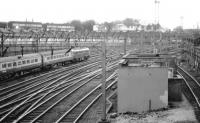
Euston: An early evening departure climbs out of Euston in October 1971. Photographed looking north west from Granby Terrace bridge with part of the huge Euston Downside Carriage Shed in the background. Built by the LNWR in 1905 the facility was eventually demolished in 2018 (having been out of use for some time) as part of the preparatory works for HS2.
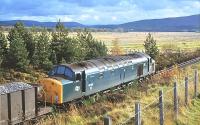
Moy: A PW train at Moy on Sunday afternoon 22 October 1978, with 40120 in charge.

Coatbridge Central: 314 205 at Coatbridge Central in October 1987 with a train for Milngavie.
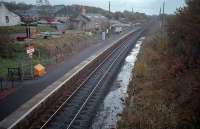
Dunlop: Dunlop, looking south. Since the photograph (1987) the line has been re-doubled and the second platform re-built. Note the old stone goods shed (then in use for a building company) in the background and lack of modern housing estate. Also the trees were quite a bit smaller! The trackbed appeared pretty diesel soaked - this was back in the days of the 47s on the Glasgow - Dumfries - Carlisle service. For the view twenty years later see image [[23681]].

Firth Viaduct: View east across Firth Viaduct, Auchendinny, in October 2001.
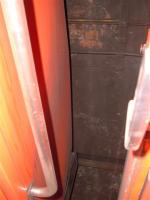
Cessnock [Subway]: Between the carrigages of the power and trailer cars. Notice the tunnel wall complete with cabling.

Bellgrove: Newly painted classs 318 at Bellgrove heading for Springburn
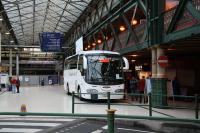
Edinburgh Waverley: Sunday morning Edinburgh - Newcastle service, relegated to single decker bus status, boarding on the western concourse at Waverley station on 22 October 2006.

Edinburgh Waverley: The planned platform renumbering omits 5 & 6, positions currently occupied by the 2 short ex-Motorail loading bays (note the ramp) and used primarily nowadays for stabling sleeper locomotives. The bays are seen on 22 October 2006 from the east end of the car park. Obvious potential exists here for any longer term expansion that may be required to east end platform capacity.

Edinburgh Waverley: Looking east along platform 11 on 22 October. The new southside platform will not run the whole length of the station as is the case on the north side but will stop short of the crossover in the background.
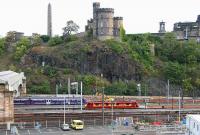
Edinburgh Waverley: Sunday morning - east end - 22 October 2006.

Edinburgh Waverley: Looking east over the newly extended bay platform (the new 3) from the non-platform on which part of the Royal Mail depot was built.

Edinburgh Waverley: View east along the North Berwick platform (old 7, new 4) with the train reflected in the glass wall of the ops depot on the left. The area between this wall and the fenced off platform edge leads to the newly extended bay (3) which starts at the rear of the ops depot.

Edinburgh Waverley: View from the top of the station car park on 22 October 2006 showing the east end stabling bays alongside the North Berwick platform. Note the old Motorail loading ramp still in place.
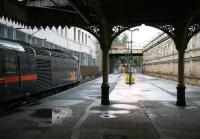
Edinburgh Waverley: The south west corner of Waverley station on a grey and damp October morning in 2006. The HST has recently arrived as empty stock from Craigentinny Depot and is currently standing alongside platform 21. It will later form the 0910 GNER Sunday service to Aberdeen. Straight ahead is part of Waverley Bridge, showing the bricked-up section of the parapet that once housed the covered entrance and stairway serving the station's suburban platforms. See image [[62893]]

Edinburgh Waverley: Aberdeen train at Waverley platform 21 on 22 October 2006. Platform 20 is out of use due to construction work (left background) in connection with the new through platform on the other side of the station wall.

Dublin Heuston: New Mk 4 DVT at the rear of a Cork departure. Mk 3 stock seen in the background.

Deauville: Looking out from the station concourse at Deauville on 22 October 2006 past a pair of diesel railcars stabled in the platform.
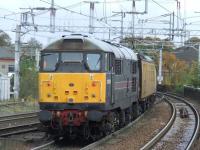
Paisley Gilmour Street: 31106 Spalding Town at the rear of overhead line test coach Mentor as it crosses Wallneuk Junction after passing through Paisley Gilmour Street

Paisley Gilmour Street: 31454 in BR InterCity livery crawls through Paisley Gilmour Street on 22 October 2008 with the overhead line test coach Mentor in tow.

Bathgate Central Junction: The 1148 Edinburgh to Bathgate service formed by an SPT Turbostar crosses from the new down line onto the up line and toward the platform at the current Bathgate station on 22 October.

Drummuir: Drummuir Station looking towards Keith, now in use by the Keith and Dufftown Railway. This station once had a loop, two platforms and a busy goods yard.

Drummuir: The remains of the goods platform at Drummuir. A set of buffer stops still remains here.

Grantown-on-Spey East: Between Grantown-on-Spey East and Nethy Bridge the trackbed is now a walkway. This timber structure supported on two metal girders replaces the original bridge over a cattle creep just south of Grantown.

Grantown-on-Spey East: A view along the trackbed about a mile south of Grantown-on-Spey East on the way to Nethy Bridge.

Grantown-on-Spey East: The four miles of trackbed between Grantown-on-Spey East and Nethy Bridge have been made into a walkway. This single file wooden bridge replaces the original structure about one and a half miles south of Grantown. View south with the River Spey in the background.

Dufftown: Class 108 DMU Spirit of Speyside at Dufftown. There are two of these units to operate the Keith and Dufftown Railway services.

Whitby: Southern Railway Schools Class 30926 'Repton' sets off from Whitby with the 1100 hrs service to Pickering on 22 October 2009. This is one of the services operated throughout by the North York Moors Railway but using the national network between Whitby and Grosmont.
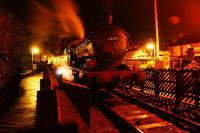
Pickering: 0-8-0 no.63395 has drawn forward from the train it has just brought in from Grosmont and into the headshunt at Pickering station, on the evening of 22 October 2009.

Pickering: Ex NER Q6 0-8-0 no. 63395 has just arrived at Pickering with the 1730 hrs ex Whitby on 22 October 2009. The engine had taken over at Grosmont from ex SR no 30926 and is preparing to run round and head to the shed at New Bridge for the night. See image [[34488]]

Grosmont: Looking north along platform 2 at Grosmont station on 22 October 2009 as ex BR Standard 4 2-6-0 76079 runs round a train that it has just brought in from Pickering.

Glassaugh: All that remains of Glassaugh Station on the Moray Coast Route. It was a two platform station with a goods yard and a small bay platform. The westbound platform has been demolished. View looks west towards Cullen.

Tochieneal: The goods platform at Tochieneal Station a mile and a quarter from Cullen. Although not far from Cullen it was larger with a more extensive goods yard.
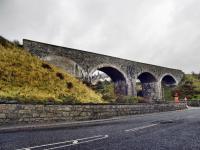
Cullen Castle Street Viaduct: The Great North of Scotland Railway was denied easy access to Cullen as The Earl of Seafield, being a director of the Highland Railway, refused to allow it to cross his land. Because of this the first quarter of a mile between Cullen and Portknockie has three viaducts and a bridge. This is the second viaduct going west.

Cullen Seafield Street Viaduct: Immediately west of Cullen Station was this four arch viaduct which crosses the main road, the only way to get all the arches in the picture was to stand in the middle of a busy road, so this will have to do.

Cullen Burn Viaduct: The main eight arch viaduct on the approach to Cullen from Portknockie. Picture taken from the next viaduct in line.

Cullen Burn Viaduct: The impressive viaduct at the west end of Cullen looking towards Portknockie. The eight arch viaduct crosses the main A98, a slip road to the beach and the Burn of Deskford.

Cullen Burn Viaduct: Looking over the eight arch viaduct at Cullen towards Portknockie, one and three quarter miles in the distance. The viaduct is now part of a walkway/cycle path and has been re-surfaced with concrete.

Cullen Burn Viaduct: The eight arch viaduct at Cullen looking east, in the rain.

Tay Viaduct [Perth]: An Aberdeen - Glasgow Queen Street service rolls across the Tay viaduct on a wet and windy 22 October 2010 on the approach to Perth station, where it is scheduled to arrive at 14.11.
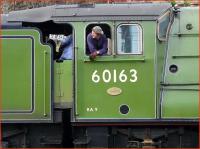
Edinburgh Waverley: Cab view of A1 Pacific no 60163 Tornado standing at Edinburgh Waverley on 22 0ctober 2010 with The Royal Borderer special from Doncaster.
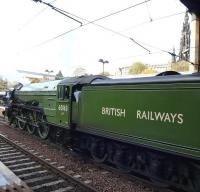
Edinburgh Waverley: A1 Pacific no 60163 Tornado photographed shortly after arrival at Edinburgh Waverley station on 22 October 2010 with The Royal Borderer special from Doncaster. The Scott Monument stands alongside Princes Street in the right background.
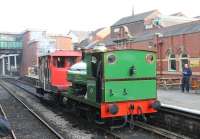
Bury Bolton Street: The immaculate Peckett 0-4-0ST May looks a picture while employed on brake van rides at Bury Bolton Street during the East Lancs autumn gala. Having worked for many years at nearby Yates & Duxbury's paper mills See image [[33097]] she is very much at home in Bury.
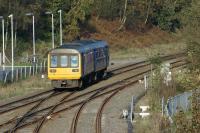
Lostock Junction: Northern 142055 comes off the line from Crow Nest Junction at Lostock Junction and heads towards Bolton while working a service to Manchester Victoria in October 2011.The line coming in from the left is from Euxton Junction and Chorley. It is also the line that Lostock station is located. The Euxton Junction to Bolton line has since been electrified and that to Crow Nest Junction and Wigan was recently approved for this too.
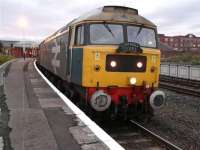
Kilmarnock: Eight o'clock on a Saturday morning at Kilmarnock station, with 47580 (plus 57601 on the rear) having recently arrived with a special to pick up passengers. The date is 22 October and the train is the outbound Compass Tours Ayr - York 'Settle & Carlisle Express'.
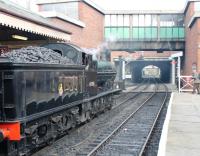
Bury Bolton Street: LNWR 7F 0-8-0 Super D 49395 proved a popular visitor to the ELR for the Autumn Steam Gala and is seen here waiting to leave Bury for Rawtenstall. I remember this National Collection locomotive as a rusting hulk at the Ironbridge Gorge Museum so it was an added pleasure to see it gleaming at the head of a six coach train and travel behind it.

Atherstone: Walking with Beyer Garratts: this sylvan scene contrasts with its past as a colliery line using a particularly heavy and powerful locomotive (see image [[26499]] for the other end of the footpath and a further link). It contrasts even more with its present neighbour, the A5. I had to run across the road from my parked car to get this picture, and run back! Even in the 1950's, big queues built up at the level crossings here and at Willey, some twelve miles South-East. This view looks West.

Ramsbottom: During the ELR Autumn Gala a demonstration freight ran between Bury and Ramsbottom several times each day. The rake of restored goods wagons made an impressive sight although due to the late non-availability of 71000 Duke of Gloucester the freight ran with industrial rather than mainline motive power. The train is seen here arriving at Ramsbottom and running through the station into the refuge loop.

Nuneaton North Chord: So it's really happening. £26M of Nuneaton North chord will emerge from the bare earth here over the next nine months. The new link will enable cross country freight traffic approaching Nuneaton from the east (in particular container trains from Felixstowe) to join the down WCML without having to cross the up main line on the level to the south of Nuneaton station, as at present. Traffic on the cross country route will increase following inauguration of the Ipswich chord which will enable trains from Felixstowe for destinations north of Nuneaton to avoid using the heavily congested North London Line to reach the WCML see image [[5098]]. View is north east on 22 October 2011, with the WCML in the background.
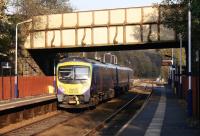
Lostock: A TransPennine service to Manchester Airport calls at Lostock station on 22 October 2011. Immediately beyond the platforms is the junction with the line from Wigan via Westhoughton joining from the right. See image [[29542]] for the view towards the station from the junction.
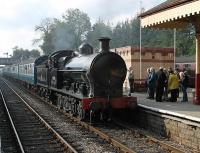
Bury Bolton Street: Plenty of admiring glances for LNWR Super D 0-8-0 49395 as it arrives in Bury Bolton Street, and this train was full when it departed for Rawtenstall. Other services at the 2011 ELR autumn gala were hauled by Black 5 45231 and 4MT 2-6-4T 80080.

Lostock: A service for Manchester Victoria departs from Lostock station and is about to cross Lostock Junction on 22 October 2011. The train has come from Blackpool North and travelled from Preston via Chorley. The line joining from the right is from Wigan and Westhoughton.

Nuneaton North Junction: View from a footbridge looking south east towards Nuneaton station with Abbey Junction and Birmingham behind the camera. The lines just off picture to the right (between excavator and new flats) cross the flyover over the WCML and run into platforms 6 and 7 on the east side of the station see image [[32902]]. The new Nuneaton North Chord, on which work has recently commenced, will provide a link between this line and the northbound WCML off picture to the left. This will allow rail traffic coming off the flyover to join the down WCML without the need to cross the up main line at the south end of the station as at present. Before joining the WCML the new chord will pass over the existing link between Abbey Junction and Nuneaton North Junction. Note vegetation clearance in progress.

Nuneaton Abbey Junction: Not much has happened to this bridge since trains to Loughborough and Burton stopped running under it and Stoney Road was diverted away from its deck. But there are stirrings in the area - earthworks in the background mark the building of a site compound for the Nuneaton North Chord project. Unfortunately, the brief for this project includes the demolition of this bridge. View looks East on 22 October 2011, with the WCML about half a mile away.
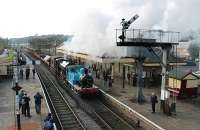
Ramsbottom: A demonstration freight rolls into Ramsbottom from Bury behind 0-6-0T MSC 32 and 0-6-0ST WD 132 during the ELR Autumn Gala. Even without the smiley face it was immediately obvious to my young grandson who was pulling the train.
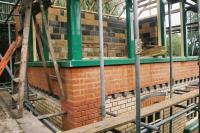
Thuxton: Thuxton Signal Box under construction in 2011 on the Mid-Norfolk Railway.
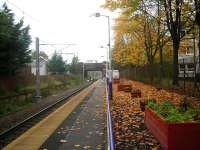
Crookston: Autumn leaves at Crookston on 22 October 2012. View is east towards Glasgow Central, with overhead equipment now in place as part of the electrification of the Paisley Canal branch.
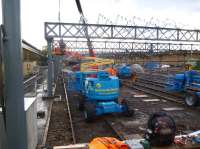
Perth Carriage Sidings: Work on the replacement of the old carriage shed at Perth on 22 October 2013. See image [[9959]]
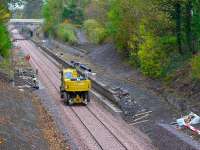
Eskbank and Dalkeith: A road-railer passes through the old Eskbank station site on 22 October 2014.
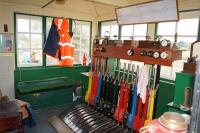
Shillingstone: Inside the signalbox at Shillingstone, which has been recreated on the site of the former station, on 22 October 2014. At that time there weren't too many points or signals in place for the box to control.

Blandford Forum: Looking north from the site of Blandford Forum station on 22 October 2014. Most of the site has been redeveloped with housing and a car park but there are tell tale signs around of former use. On the right with the recently boarded up windows is the old station house, while to the left is the footbridge over the trackbed towards Sturminster Newton (now part of the North Dorset Trailway). Beyond the 5 bar gate is a short length of track and buffer stops. [Ref query 4248]
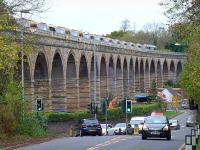
Newbattle Viaduct: A ballast train crossing Newbattle Viaduct on 22 October 2014.
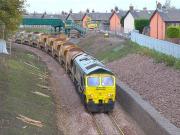
Newtongrange [1st]: Freightliner 66605 with a ballast train at the site of the former Newtongrange station on 22 October.
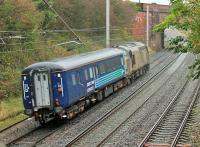
Hest Bank: Light work for a Type 3. A very grubby DRS 37409 'Lord Hinton', presumably on a break from Sandite duties, takes a much cleaner MkII Brake from Kingmoor to Crewe Gresty Bridge through Hest Bank on 22nd October.
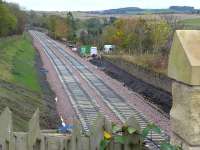
Fushiebridge [1st]: View south at Fushiebridge on 22 October 2014.
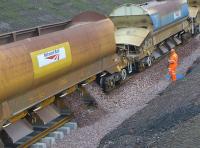
Newtongrange: Ballast dropping on the Borders Railway at Newtongrange on 22 October 2014.
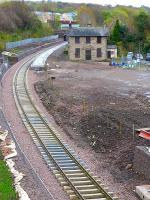
Gorebridge: Looking south over Gorebridge Station with track laid on 22 October.
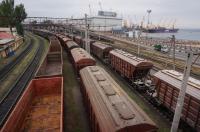
Odessa: A photo of grain wagons at Odessa on 22 October 2014. Even then, there was a considerable feeling of unrest and our tour guide was very careful about where we stood.
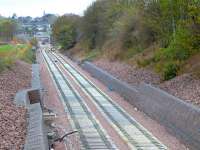
Fushiebridge [2nd]: View north at Fushiebridge on 22 October 2014. Some of the rail installation equipment waits at the end of the loop, the limit of track laid at this time.
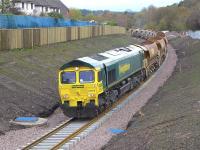
Newbattle Signal Box: Ballast train on the northern approach to Newtongrange station on 22 October 2014 behind Freightliner 66605.
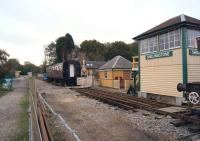
Shillingstone: Recreating a small section of the S&DJR at Shillingstone with the track relaid through the Up Platform and the station buildings restored and signalbox replaced. Scene on 22 October 2014 looking south towards Blandford Forum.
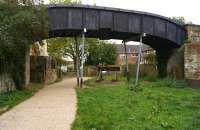
Blandford Forum: The trackbed into the station site at Blandford Forum on 22 October 2014 with the footbridge over the trackbed supporting a smoke deflector - although a local source suggested that this had been added as part of the 'recreation' along with the buffer stop underneath.
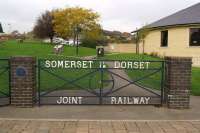
Sturminster Newton: A set of gates at the entrance to 'The Railway Gardens' in Sturminster Newton in October 2014, with the name of the company which operated the railway. The blue plaque on the left gate post and placed there by the S&DJR Trust is inscribed Here once passed the engines and men of the Somerset & Dorset Joint Railway, Closed 7 March 1966.

Blandford Forum: Remains of the railway viaduct over the River Stour to the south of Blandford Forum station site in 2014.
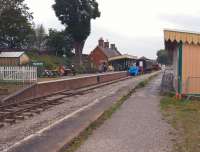
Shillingstone: The restored heritage station at Shillingstone in October 2014. The Shillingstone Railway Project has worked wonders on the old station, especially when compared to the state of the site when I last visited over 30 years ago. See image [[49309]] Since then it has been the subject of a successful renovation / heritage campaign and was opened to the public in 2008, incorporating a museum, shop and station cafe.
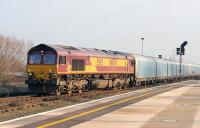
Didcot Parkway: 66076 brings a very long car train into the station sidings at Didcot on 22 January 2015.
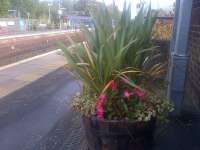
Barrhead: Late blooming flowers adorn the southbound platform at Barrhead and, across the way, a Sprinter rests in the bay platform.
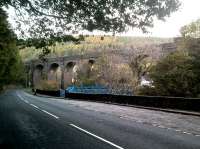
Pontrhydyfen: As the road beneath curves right, the single track rail viaduct curves to the left - honest! You will also have to take it from me that there is an equally elegant former canal viaduct to the right, and that access to the cyclepath across the viaduct is from a path around the back of a closed school on Oakwood Avenue. View looks North-East. [Ref query 44441]
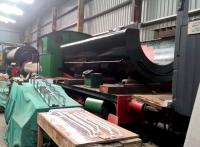
Pontycymer: One for April 1st.. the Garw Valley Railway at Pontycymer is privileged to own the only surviving prototype of the GWR 'belly tank' locomotive, which was intended to increase stability on sharply curved Valley lines, on the principle that water is heavier than steam, so you might as well keep it down the bottom, like.
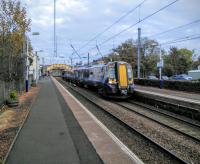
Glengarnock: A 380 with an afternoon service to Ayr calls at Glengarnock on 22/10/2016. You'll have to imagine the autumn smell of brown leaves.
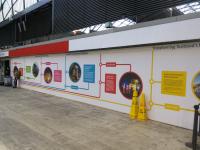
Glasgow Queen Street High Level: Your journey on the Edinburgh to Glasgow Improvement Programme. A frieze (if that the right word) with a distinct Harry Beck influence. Photographed 22/10/2016.

Airdrie: 334 008 pulls out with a westbound service while 318 254 sits in the bay. Trains from Balloch are timed to arrive shortly after the last one going the other way has departed, so that Platform 1, on the right, is occupied for most of the time. Photographed 22/10/2016.
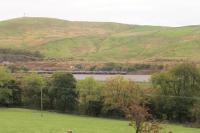
Dillicar Watertroughs: Two TPE 350 EMUs run across a refurbished embankment (one of many between Lancaster and Carlisle) in the Lune Gorge at Dillicar on 22nd October 2016. The M6 Motorway, on two levels at this location, can be seen behind the line.
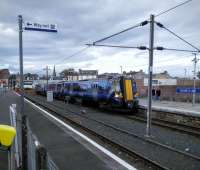
Largs: A 380 about to depart Largs for Glasgow on 22/10/2016. The second platform must be used in the morning only when there are two departures which happen too close together to allow time for a service train to come in to form one of them. That's not particularly close, but it's a long single track section to Saltcoats which limits frequency. Now if the parallel freight-only line from Hunterston to the junction were electrified and opened up to passengers, and second platforms built at West Kilbride and Ardrossan South Beach, they could just manage half-hourly ...
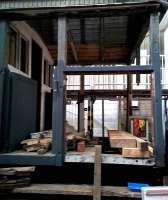
Pontycymer: The Welsh certainly like their fresh air. Partly restored brake van in the GVR shed, seen on a Railway Ramblers visit in October 2016. see image [[57981]]
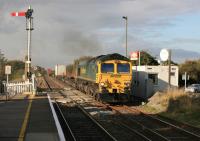
Whittlesea: 66566 passing Whittlesea with the 2201 Coatbridge to Felixstowe service, poorly loaded on this occasion. The station here has staggered platforms and still boasts proper signals! A crossing keeper is based in the building behind the loco and is kept very busy.
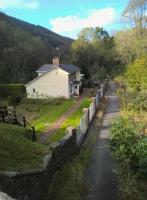
Llangeinor: This crossing keeper's cottage at Llangeinor on the Blaengarw branch seems to have been extended in most available directions. Photographed from the bridge which replaced the crossing - view looks North.
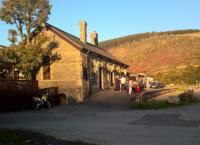
Cymmer Afan: The Refreshment Rooms - a pub in the former Cymmer Afan station. As the attic space is open, it is pleasant and airy inside, with fascinating pictures of old mines as far afield as Hafodyrynys.
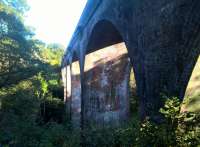
Cwm-Du Viaduct: When I first called here in 1988, in a borrowed Jaguar, I found a very hospitable local gent on the deck, and a lovely view down the valley. Now both ends are fenced off; but it's still a marvellous bridge.
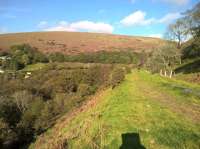
Llangeinor: One of the defining characteristics of the current Valleys rail network is that all routes crossing from one valley to another have been closed. Although the PTR&D Co line is clinging to the side of the valley here, it is about to turn sharp right behind the photographer. The Lynvi and Ogmore line see image [[57586]] is at the bottom of the valley.
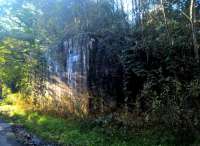
Lletty Brongu: There is something of an 'enchanted forest' look to this view of a road overbridge slightly East of Cwm-Du viaduct see image [[57139]]. Notice that the two sides of the bridge have very different facings. Historical note: this line closed from here to Cwmdu in 1960.
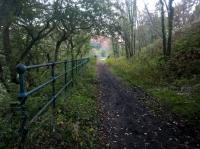
Pontrhydyfen: Looking South over the viaduct. see image [[56972]]
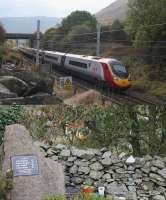
Tebay: Pendolino 390128 speeds northwards at Tebay on 221016. The train is just passing the poignant memorial to the four railway workers killed here on 15th February 2004 when a poorly maintained trolley ran away on Shap bank during an engineering possession. (Memorial map reference NY613028.)
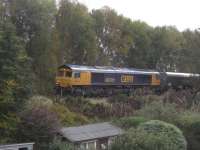
St Marnocks Junction: Not the most exciting photo ever taken, but a photo couldn't capture the very impressive sound of GBRf Class 66 No 66701 hammering up the line from Barassie and onto the steep gradient up to Kilmarnock station with a loaded coal train at 1438 hrs on Saturday, 22 October, 2016. These coal trains have always tended to be timed through Kilmarnock to clash with passenger services in and out of the station so the norm is for them to get amber at the distant signal down towards Moorfield and they either slow down or crawl past the old St. Marnocks signalbox site to the outer home signal further up the gradient, where they can be held for anything up to 25 minutes. Being a wee bit later on the day (the Glasgow service departs at 1430hrs) No 66701 obviously got greens all the way so the driver had applied the boot to get some momentum for the climb up to the station.
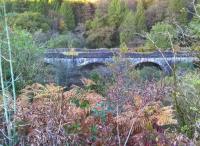
Cymer Afan: The other viaduct at Cymer see image [[49912]]. This one is oriented East-West, and was damaged by a derailed coal train in 1962. The parapets have still not been repaired. View looks North.
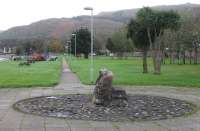
Campbeltown: This footpath, running south west alongside the shore at Campbeltown, follows the line of the old light railway. At the sixth lamp post the path swings west and follows the course of the old railway into the little glen where it climbs steeply away from sea level. 22nd October 2017.
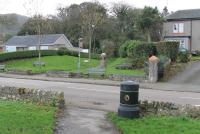
Campbeltown: This footpath at Campbeltown follows the course of the narrow gauge railway and is seen here entering the small glen where there was a 1:35 gradient for trains to tackle as they headed for Machrihanish.
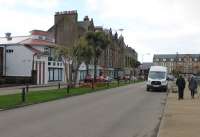
Campbeltown: The site of the C&MLR station on the quayside in Campbeltown in October 2017. The two lines of the run-round loop were approximately where the central flower bed now sits. Of note is the Grade A listed Campbeltown Picture House, now nearing the end of a long restoration. This was built in 1913 and so witnessed the C&MLR trains operating until the 1932 closure of the railway.
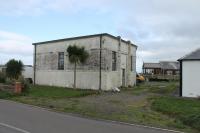
Argyll Colliery: The last surviving building (the old sub-station) at the Argyll Colliery sits alongside the Machrihanish caravan park that now occupies the remainder of the site. For a while this was used as a pub known as the Laggan Bar but no longer. Argyll Colliery started producing coal in 1950 and was close to another mine of the same name that had closed in 1929. The first mine sent coal out to Campbeltown Harbour by canal from Drumlemble and then the narrow gauge railway (which ran just behind the camera) but the new mine had to use road transport. It ceased production in 1967 although the pit head baths stood alongside the road until 2005 before demolition. [Ref query 25 October 2017]. [With thanks to Malcolm Chattwood for colliery information].

Haddington: The climb - steps up to the former Haddington station.

Haddington: Interpretive signalpost on the Haddington Railway Walk.
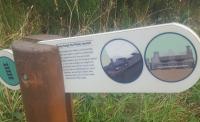
Haddington: Haddington Railway Walk, the reverse side of the interpretive signalpost.
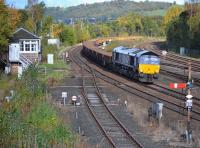
Stirling North Junction: DRS 66303 passes Stirling North signal box with an empty ballast to Millerhill. The main line was blocked at Cornton a little to the north for EGIP work, with Alloa branch (on the right) services unaffected.
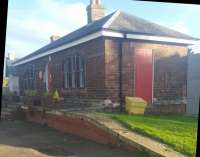
Haddington: The surviving building at Haddington station is now the home of Lamp House Music.
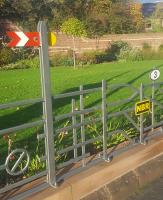
Haddington: New railway themed artwork in front of the old station at Haddington on 22nd October 2017.
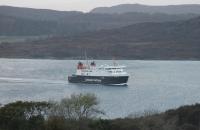
Kennacraig: The Calmac ferry Finlaggan sails up West Loch Tarbert towards Kennacraig terminal after crossing from Islay on 22nd October 2017.
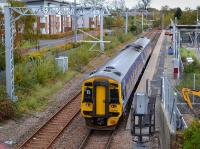
Alloa: 158707 arrives at Alloa with the 10.20 from Glasgow Queen Street on 22nd October 2018. The little-used Longannet line passes to the left.
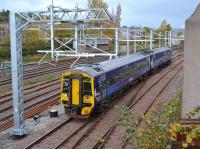
Stirling North Junction: 158707 nears Stirling with the 11.42 from Alloa to Glasgow Queen Street on 22nd October 2018. Stirling North signalbox can be glimpsed through the electrification metalwork.
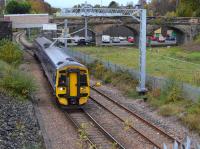
Alloa: 158707 takes the platform line at Alloa with the 10.20 from Glasgow Queen Street on 22nd October 2018. The former station site is in the background.

Dunblane: DRS 66423 restarts from a signal check at Dunblane with the Grangemouth - Aberdeen intermodal. The payload was only four containers.
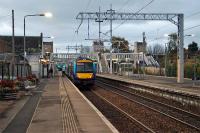
Dunblane: The first day of services 'under the wires' at Dunblane was Monday 22nd October 2018. On that day, the 07.58 to Edinburgh is seen readying for departure.
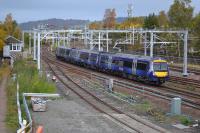
Stirling North Junction: 170406 passes Stirling North signalbox with the 09.07 from Dyce to Glasgow Queen Street.
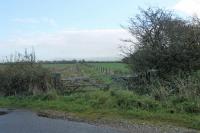
Preesall: A slight rise in the road and these typically KER concrete gate posts mark the site of Green Dick's Crossing, almost mid way between Preesall and Pilling stations (Map Ref SD 384475). This view looks east towards Carr Lane Halt See image [[28773]] and Pilling in October 2018 but, 68 years after final closure, the trackbed has disappeared into the farmland. Behind the camera a crossing keeper's cottage still stands but heavily modified and extended. Passenger trains only ran on the Pilling to Knott End section of line from 1908 to 1930 with a sparse freight service continuing until 1950.
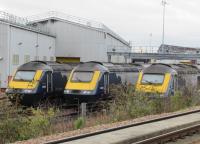
Haymarket MPD: Three of several HST (or bits of them) languishing at Haymarket depot on 22 October 2019. Meanwhile 170s or even two-car 158s are doing what should surely be HST duties, certainly on the Highland Main Line. Go figure.
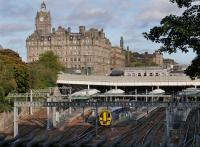
Edinburgh Waverley: 158730 leaves Waverley platform 16 with an empty working to Haymarket Depot on 22nd October 2021.
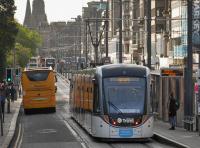
Princes Street [Tram]: Tram 261 calls at Princes Street stop, heading for the airport, on 22nd October 2021. Destination boards are now in use with the electronics playing up.
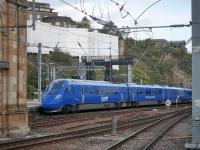
Edinburgh Waverley: 800302 arrives at Edinburgh Waverley with the 10.45 LUMO training run from Kings Cross on 22 October 2021.
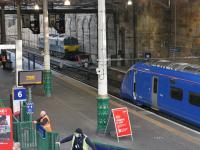
Edinburgh Waverley: 800302 stands at Waverleys platform 11 with the 16.12 LUMO training run to Newcastle on 22nd October 2021. Caledonian Sleeper loco 92010 is in the background.
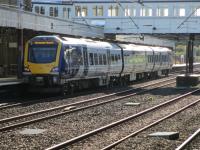
Lancaster: CAF 195110 arriving at Lancaster, with the late running 11.49 Northern service to Manchester Airport in October 2021.
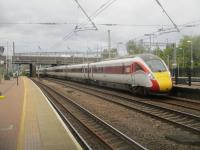
Alexandra Palace: This LNER Azuma unit still has three and a half miles to go to King's Cross as it speeds past the disused and fenced-off former up main line platform at Alexandra Palace station, on the afternoon of 22nd October 2021.

Petteril Bridge Junction: Following Wednesday's accident, cement tanks fell off the Petteril Bridge, even turning upside down, as a result of the derailment at the nearby junction. This was the scene four days later, and the recovery will take a long time.
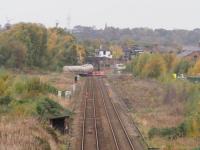
Petteril Bridge Junction: A view from the east of the derailed cement train at Petteril Bridge Junction taken on the 22nd. Theres no heavy lifting gear on site yet.
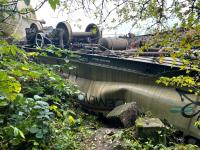
Petteril Bridge Junction: This inverted and flattened cement wagon illustrates the scale of damage at the Carlisle derailment and why the scene will take some time to clear.
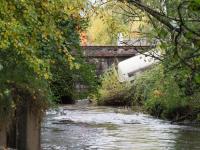
Petteril Bridge Junction: View down the River Petterill towards the rail bridge at the junction with a Castle Cement tanker on the bank awaiting recovery, one of several wagons involved in the October 2022 derailment.
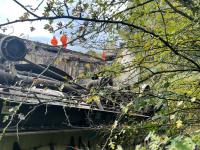
Petteril Bridge Junction: Wreckage of cement wagons at the site of the Petteril Bridge Junction derailment seen three days after the 19th October 2022 incident. An overturned wagon in the foreground, another almost in the river but upright beyond, and the bridge parapet missing too.
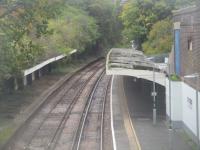
Chessington South: Zoom lens view of Chessington South, looking towards London Waterloo, on the afternoon of Saturday, 22nd October 2022. On the left is the never used up platform that would have served trains from Leatherhead had that section been completed. On the right on the station building, the blue board blocks the corridor from the ticket office that would have led onto the never built footbridge.
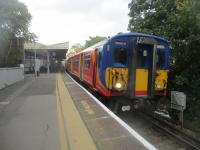
Raynes Park: 455s 5718 and 5872, with the ex-13.47 South West Trains service from Waterloo to Chessington South, arriving at Raynes Park on Saturday, 22nd October 2022. The down main platform is to the left while the up line from the Epsom direction passes under all four main line tracks to come up into the north side of the up island platform, staggered from the south. (See my photo image no. 83083, taken same day, for further brief details of this station's history.)
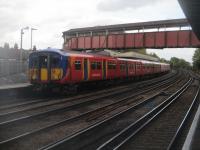
Raynes Park: The London & Southampton Railway had opened in 1838 but Raynes Park station was not opened until 30th October 1871 by the London & South Western Railway and sited where the 1859 line to Epsom via Ewell diverged. The layout was altered in 1884 when the station was given staggered island platforms on both sets of lines with a new flyunder below the main line tracks from the Epsom line, taking those trains into the outer edge of the up main platform, behind where this Woking to Waterloo service calls on the afternoon of Saturday, 22nd October 2022. The down Epsom line was also given its own platform to the south of the down main from which this scene was taken.
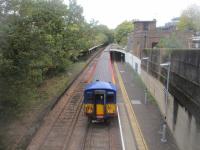
Chessington South: View from road overbridge at Chessington South with 455s 5718 and 5872 departing with the 14.36 service to Waterloo, on 22nd October 2022. The station, originally to have been called Chessington Grange, was opened on 28th May 1939 and intended as a through station and the never used platform meant for up trains from the uncompleted Leatherhead extension (with never built stations at Malden Rushett and Leatherhead North) is on the left. An intended footbridge was never built. The tracks continue beyond the south side of the road bridge on the projected Leatherhead extension but only a few yards were built. Other stations on this branch are on embankments but the terminus is in a cutting. NB: This is not and never has been part of the LPTB, it was the last line in the UK to be opened by the post-Grouping Southern Railway immediately before the start of World War Two.
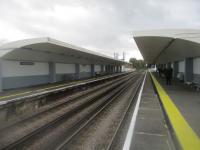
Chessington North: The distincitve large canopies at Chessington North are typical of all the stations on the branch to Chessington South, seen here looking towards the latter on the afternoon of Saturday, 22nd October 2022. This station was opened on 29th May 1939 with the extension from Tolworth to Chessington South, Tolworth having been reached from Motspur Park exactly a year earlier. Before opening, it was to have been called Chessington Court but eventually the name Chessington North was settled on. NB: This is not and never has been a LPTB station, it was opened with the line by the post-Grouping Southern Railway.
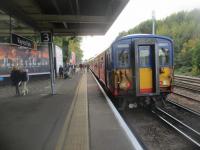
Raynes Park: 455 5706 and a classmate calling at Raynes Park with the ex-13.42 South West Trains service from Waterloo to Shepperton via Kingston, on the afternoon of Saturday, 22nd October 2022. The train will head away from the camera when it departs.
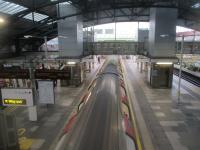
Morden: Morden, southern terminus of the Northern Line, looking north from the footbridge with a train of LU 1996 stock waiting to depart for Edgware via Bank, on the evening of Saturday, 22nd October 2022. This station, designed by Dr. Charles Holden (1875-1960), opened with the extension of the City & South London Railway from its 1900 terminus at Clapham Common on 13th September 1926. The line was then renamed the Morden-Edgware line until 1937 when the LPTB renamed the whole line as the Northern Line, notwithstanding that a long section of it, as here, is in SOUTH London!
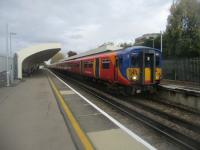
Tolworth: 455s 5719 and 5834 to Chessington South arriving at Tolworth on 22nd October 2022. This station was the temporary terminus of the line from Motspur Park that opened on 29th May 1938 before extension to Chessington South one year later on 28th May 1939. The distinctive canopies are a feature of all the stations on the branch.
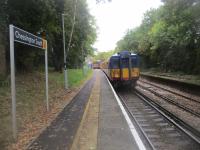
Chessington South: Chessington South was intended as an intermediate station on a loop line from Motspur Park to Leatherhead but, even though it was reached from Motspur Park in 1939, the line was never completed and the station has always been the terminus. However, before the decision was taken not to proceed, an up platform was constructed but never used and its remains and track are still there today on the right, complete with buildings further down behind the train. The tracks extend beyond the bridge in the background and I am indebted to Simon Neave, who first contacted me through Railscot, that these now go to a stone terminal that stretches some distance south along what would have been the continuation to Leatherhead. Standing at what should have been the down platform, 455s 5872 and 5718 have recently arrived with the ex-13.47 South West Trains service from Waterloo and are waiting time on the 14.36 return on Saturday, 22nd October 2022. (NB: This is not and never has been part of the former LPTB, it was opened by the Post-Grouping Southern Railway.)
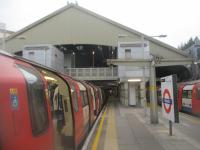
Morden: Morden, southern terminus of the LU Northern Line, with trains of LU 1995 stock waiting to depart, looking south on the afternoon of Saturday, 22nd October 2022. While a terminus as far as passengers are concerned, the station is laid out as a through one with the tracks continuing to the depot, which is within sight and sound of Morden South station on the Wimbledon to Sutton line. Plans for a connection here to allow tube trains to run to Sutton were never realised.
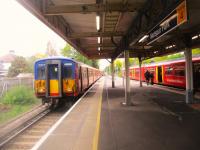
Motspur Park: Motspur Park, on the line between Raynes Park and Epsom and the junction for the Chessington South branch, seen here with 455s 5834 and 5719 departing with a Chessington South to Waterloo service, on the afternoon of Saturday, 22nd October 2022. On the right, 5857 and 5739 are calling with a service from Waterloo to Dorking via Wimbledon and Epsom.
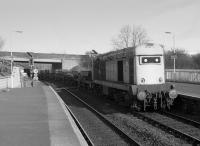
Inverkeithing: A class 20 hauls wagons for scrapping from Inverkeithing Yard to the former Ward's yard, through the station in 1988.
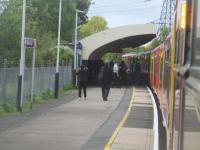
Malden Manor: Malden Manor, seen from the ex-13.47 service from Waterloo to Chessington South, on the afternoon of Saturday, 22nd October 2022. This is the first station on the Chessington South branch that was opened from Motspur Park on the Wimbledon to Epsom line as far as Tolworth, the next stop along, by the Southern Railway on 29th May 1938 before extension to Chessington South with an intermediate station at Chessington North on 28th May 1939. All the stations are of the same basic design with concrete much in evidence.
Events
Events from the chronology which occured on this day. This generally lists events before 1995, the creation of the website.
| Year | Companies | Description |
|---|---|---|
| 1860 | Wilsontown Branch (Caledonian Railway) | Line opened from 1st_>Wilsontown Junction 1st to Wilsontown. |
| 1883 | Gwendraeth Valleys Railway | Abbeydore closed |
| 1900 | Dundee Corporation Tramways | Electric trams introduced on Lochee route. |
| 1972 | Glasgow Central Station (Caledonian Railway) | Powerbox modernised. |
| 1979 | Perth and Dundee Railway | 5 are killed (sources vary, some say 4) when two trains collide near Invergowrie when one over-runs a signal. A Glasgow to Aberdeen service runs into the rear of a Glasgow to Dundee local train resulting in carriages falling into the sea. The cause was a deficient semaphore which did not return to danger. |
News
These are old news items which which occured on this day. This generally lists events after 1995, the creation of the website.
| Year | Companies | Description |
|---|---|---|
| 2002 | Flooding affects services | This was a day of disrupted services. The North Berwick Line flooded, there was a track defect at Gartshore and flooding between Linlithgow and Edinburgh Haymarket (Edinburgh to Glasgow line), flooding at Inverkeithing, a landslide between Aberdeen and Stonehaven, and flooding of the Bathgate line. The East Coast Main Line was closed between Edinburgh and Berwick. |
| 2008 | Railway station spending welcomed [Courier] | Almost £300,000 is being spent to improve customer services at Montrose railway station. [From John Robin] |
| 2009 | Harwich line passenger services suspended till 9 November [Network Rail Article] | Passenger services on the line between Manningtree and Harwich are suspended until Monday 9th November following a landslip near Harwich. Buses currently replace trains between Manningtree and Harwich. |
| 2012 | Chiltern Railways gets powers for Oxford to London project [Railway Gazette] | The Secretary of State for Transport has granted legal powers under the Transport & Works Act for the £130m Evergreen 3 project to provide a new route between London and Oxford, Chiltern Railways announced on October 18. |
| 2014 | Britain’s railway network – Transport mode of choice [GlobalRailNews] | In his recent address to the Institution of Engineering and Technology’s 2014 Sir Henry Royce Memorial Lecture in London this September, HS2 technical director Andrew McNaughton set out his vision for the future of Britain’s railways. |
| 2016 | Travel warning for Scotland^s rail passengers [BBC News] | Rail passengers have been advised to check their travel plans, as the latest phase of improvement works begin. A revised timetable has started that will last until December. ScotRail said the engineering work is being carried out to increase ^overall reliability^ and to pave the way for new electric trains. Some services will be replaced by buses and queuing systems will be in place at key stations as trains could be diverted, less frequent or cancelled. |
| 2017 | Nicola Sturgeon set for showdown with rail bosses after £795m project is delayed yet again [Sunday Post] | NICOLA STURGEON told train bosses to get their act together at crunch talks after yet another delay to the introduction of electric services on the flagship Edinburgh to Glasgow line. The First Minister called a summit with Hitachi, which is building 70 electric trains for ScotRail, after the Japanese firm was hit with production problems. A full electric train service is now unlikely to run on the Glasgow to Edinburgh route until May next year. |
| 2019 | Contract for ferries to Northern Isles extended over complaints [Press and Journal] | The multi million pound contract to operate ferry services between Aberdeen and the northern isles has been extended by three months. |
| 2019 | Final push as last seagoing turntable ferry company seeks to raise £10,000 to help fund repairs [Press and Journal] | Campaigners hoping to save the last manually-operated seagoing turntable ferry have hit 60% of their fundraising target. |

